At George Washington’s Mount Vernon, a luscious crop of hemp nears harvest time
Dean Norton, director of horticulture at George Washington’s Mount Vernon, pulls out his cellphone and cranks up some Jimi Hendrix music as he walks toward the cannabis patch on the founding father’s estate.
The “weed” is tall, planted in tight rows and has the serrated leaf edges of your classic ganja.
As Hendrix’s 1968 epic “Voodoo Child” drifts from the phone, Norton jokes about having a suitable vibe for the plot. “We should have a speaker in the middle,” he says. “Would people go nuts? “
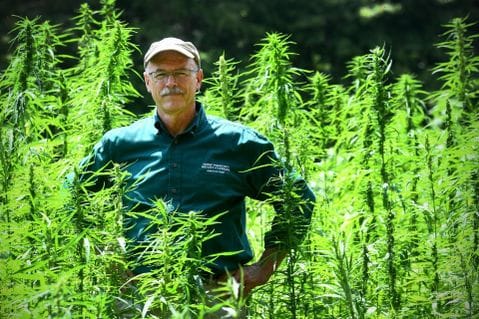
Dean Norton, director of horticulture at Mt. Vernon
But this is not that kind of hemp. You don’t smoke this stuff. This is raised for its fiber. It’s industrial hemp, the kind Henry Ford sought to build cars with. And Mount Vernon has started growing it because George Washington did.
The landmark home of the nation’s first president, about 20 miles south of Washington, is part of an effort to return industrial hemp to its historical context and promote its use in the modern world.
Industrial hemp, while cannabis, is far different from its marijuana cousin.
While both contain tetrahydrocannabinol, THC, the substance that’s creates the “high,” industrial hemp contains only tiny amounts of THC and has no psychoactive effect, experts say.
Recreational marijuana has roughly 10 to 30 percent THC in its dry weight of flowers, said Michael P. Timko, professor of biology and public health sciences at the University of Virginia. Industrial hemp has .3 percent or less.
But the industrial strain, which was widely grown in colonial Virginia to make fiber for rope and other products, became lumped over time with the recreational strain. And both were stigmatized and suppressed in the early 20th century.
“You have different strains for different things,” Norton said recently as he stood near his hemp patch, down the hill from Washington’s famous manor house. “They’ve really been able to come up with . . . really strong fiber plants, really strong oil plants and really strong recreational plants.”
“But that’s not what we’re doing here,” he said. “This is totally for interpretation purposes. . . . You could a build bonfire with this, sit around it, breathe it, nothing’s going to happen.”
Still, Norton needed a license to cultivate. “My kids love to say I’m a grower,” he said. “I’m (license) number 86 . . . I think it’s really cool.”
Mount Vernon visitors are intrigued.
“The funniest thing is the people that are familiar with hemp, or the other,” he said. “They stop. They look. They go take pictures. [They’ll say] ‘Remember the old VW bug we had.’ It’s always a VW. It’s great. It’s really fun to watch the people that know.”
Industrial hemp was an important crop in colonial times. A sailing ship could require thousands of feet of hemp rope for its rigging, Norton said.
Hemp “is abundantly productive and will grow for ever on the same spot,” Thomas Jefferson wrote of it.
Jefferson invented a special hemp “break” for processing it. He wrote that he used hemp “for shirting our laborers” — his slaves — because cotton was too expensive.
In the 1700s, it was so valuable that Virginia paid farmers to grow it. Washington took advantage of that, writing in 1767, that he “applied to the fund for giving a Bounty on Hemp.”
He planted it in abundance, especially in one tract he called Muddy Hole.
But it was a labor-intensive crop.
The outside fiber had to be separated from the inner core, or “hurd.”
It had to be pulverized, then soaked in water or dew, to help in the extraction. But when the process was completed, the fiber was long and strong.
The idea to return hemp to Mount Vernon came from Brian Walden, 37, a farmer in Charlottesville, who got the notion after a 2014 federal law cleared the way for academic research into industrial hemp cultivation, he said in a telephone interview.
Farmers were permitted to grow it if they joined a research program and partnered with a university that wanted to study industrial hemp, he said.
He connected with the University of Virginia. He “donated land, equipment, expertise,” he said, and began to grow it locally.
Last year, he came up with a hemp plan for Mount Vernon, to boost the crop’s image and illustrate its role in history. Norton was hesitant at first, but agreed this year. The first seeds were planted June 13.
The 6o-day crop should be ready for harvest soon, Walden said.
A similar plot has been planted at Montpelier, the Orange County, Va., home of founding father James Madison.
Hemp was a big crop in the colonial Mid-Atlantic, Walden said. “We couldn’t grow flax, like they can up north,” he said. “And we couldn’t grow cotton, like they do down south.”
But in the 20th century, with the rise of the recreational strain, all hemp became stigmatized. “They clumped them all together,” Walden said.
(Medicinal use of hemp/marijuana has been traced back to 1576, when it was recommended for use in treating an unstable Prussian duke, according to historian H. C. Erik Midelfort.)
In 1937, a huge “marihuana” tax was placed on hemp that “made every farmer drop it like a dime,” he said.
But in the 1940s, some production returned because of the wartime need.
In 1942, the Agriculture Department produced a 14-minute film, “Hemp for Victory,” urging farmers to grow it again.
For the sailor and the hangman, it had been indispensable in the past, the narrator declared. Now it was needed for shoe thread, parachute webbing, and 30,000 feet of rope for every battleship.
Tribe Reaches Agreement With Wisconsin Attorney General Over Plans to Grow Hemp
A northern Wisconsin tribe has reached a settlement with the state’s attorney general over its plans to grow hemp.
Wisconsin Public Radio reports that the St. Croix Chippewa Indians of Wisconsin filed the federal lawsuit in February against state Attorney General Brad Schimel, saying he objected to the tribe’s plans for processing hemp.
St. Croix tribal attorney Jeff Cormell said parties reached an agreement that the tribe will oversee hemp production to produce cannabidiol, or CBD oil, on reservation lands.
The tribe also agreed to notify the state with any changes to its ordinance.
New Billion Dollar Crop | Popular Mechanics
In February of 1938, less than 6 months after the passage of the marijuana tax act, Popular Mechanics Magazine published an article about the potential of hemp titled “New Billion-Dollar Crop.” Below is the article in its entirety with the original photos included with the article.

VOL. 69 February, 1938 NO. 2

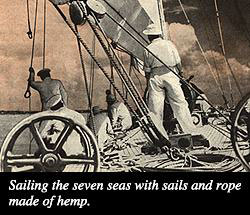 American farmers are promised a new cash crop with an annual value of several hundred million dollars, all because a machine has been invented which solves a problem more than 6,000 years old. It is hemp, a crop that will not compete with other American products. Instead, it will displace imports of raw material and manufactured products produced by underpaid coolie and peasant labor and it will provide thousands of jobs for American workers throughout the land.
American farmers are promised a new cash crop with an annual value of several hundred million dollars, all because a machine has been invented which solves a problem more than 6,000 years old. It is hemp, a crop that will not compete with other American products. Instead, it will displace imports of raw material and manufactured products produced by underpaid coolie and peasant labor and it will provide thousands of jobs for American workers throughout the land.
The machine which makes this possible is designed for removing the fiber-bearing cortex from the rest of the stalk, making hemp fiber available for use without prohibitive amounts of human labor.
Hemp is the standard fiber of the world. It has great tensile strength and durability. It is used to produce more than 5,000 textile products, ranging from rope to fine laces, and the woody “hurds” remaining after the fiber has been removed contain more than seventy-seven per cent cellulose, and can be used to produce more than 25,000 products, ranging from dynamite to Cellophane.
Machines now in service in Texas, Illinois, Minnesota and other states are producing fiber at a manufacturing cost of half a cent a pound, and are finding a profitable market for the rest of the stalk. Machine operators are making a good profit in competition with coolie-produced foreign fiber while paying farmers fifteen dollars a ton for hemp as it comes from the field.
From the farmers’ point of view, hemp is an easy crop to grow and will yield from three to six tons per acre on any land that will grow corn, wheat, or oats. It can be grown in any state of the union. It has a short growing season, so that it can be planted after other crops are in. The long roots penetrate and break the soil to leave it in perfect condition for the next year’s crop. The dense shock of leaves, eight to twelve feet above the ground, chokes out weeds. Two successive crops are enough to reclaim land that has been abandoned because of Canadian thistles or quack grass.
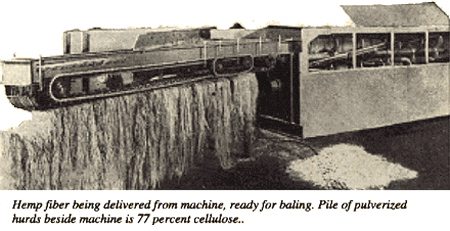 Under old methods, hemp was cut and allowed to lie in the fields for weeks until it “retted” enough so that the fibers could be pulled off by hand. Retting is simply rotting as a result of dew, rain and bacterial action. Machines were developed to separate the fibers mechanically after retting was complete, but the cost was high, the loss of fiber great, and the quality of fiber comparatively low. With the new machine, known as a decorticator, hemp is cut with a slightly modified grain binder. It is delivered to the machine where an automatic chain conveyor feeds it to the breaking arms at a rate of two or three tons per hour. The hurds are broken into fine pieces that drop into the hopper, from where they are delivered by blower to a baler or to a truck or freight car for loose shipment. The fiber comes from the other end of the machine, ready for baling.
Under old methods, hemp was cut and allowed to lie in the fields for weeks until it “retted” enough so that the fibers could be pulled off by hand. Retting is simply rotting as a result of dew, rain and bacterial action. Machines were developed to separate the fibers mechanically after retting was complete, but the cost was high, the loss of fiber great, and the quality of fiber comparatively low. With the new machine, known as a decorticator, hemp is cut with a slightly modified grain binder. It is delivered to the machine where an automatic chain conveyor feeds it to the breaking arms at a rate of two or three tons per hour. The hurds are broken into fine pieces that drop into the hopper, from where they are delivered by blower to a baler or to a truck or freight car for loose shipment. The fiber comes from the other end of the machine, ready for baling.
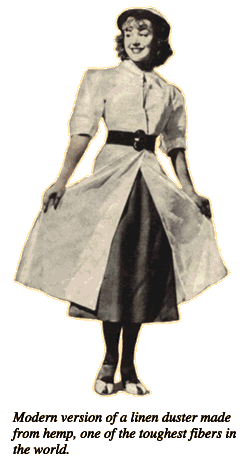 From this point on, almost anything can happen. The raw fiber can be used to produce strong twine or rope, woven into burlap, used for carpet warp or linoleum backing or it may be bleached and refined, with resinous by-products of high commercial value. It can, in fact, be used to replace foreign fibers which now flood our markets.
From this point on, almost anything can happen. The raw fiber can be used to produce strong twine or rope, woven into burlap, used for carpet warp or linoleum backing or it may be bleached and refined, with resinous by-products of high commercial value. It can, in fact, be used to replace foreign fibers which now flood our markets.
Thousands of tons of hemp hurds are used every year by one large powder company for the manufacture of dynamite and TNT. A large paper company, which has been paying more than a million dollars a year in duties on foreign-made cigarette papers, now is manufacturing these papers from American hemp grown in Minnesota. A new factory in Illinois is producing bond paper from hemp. The natural materials in hemp make is an economical source of pulp for any grade of paper manufactured, and the high percentage of alpha cellulose promises an unlimited supply of raw material for the thousands of cellulose products our chemists have developed.
It is generally believed that all linen is produced from flax. Actually, the majority comes from hemp—authorities estimate that more than half of our imported linen fabrics are manufactured from hemp fiber. Another misconception is that burlap is made from hemp. Actually, its source is usually jute, and practically all of the burlap we use is woven from laborers in India who receive only four cents a day. Binder twine is usually made from sisal which comes from the Yucatan and East Africa.
All of these products, now imported, can be produced from home-grown hemp. Fish nets, bow strings, canvas, strong rope, overalls, damask tablecloths, fine linen garments, towels, bed linen and thousands of other everyday items can be grown on American farms. Our imports of foriegn fabrics and fibers average about $200,000,000 per year; in raw fibers alone we imported over $50,000,000 in the first six months of 1937. All of this income can be made available for Americans.
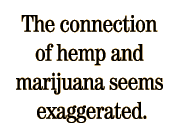 The paper industry offers even greater possibilities. As an industry it amounts to over $1,000,000,000 a year, and of that, eighty per cent is imported. But hemp will produce every grade of paper and government figures estimate that 10,000 acres devoted to hemp will produce as much paper as 40,000 acres of average pulp land.
The paper industry offers even greater possibilities. As an industry it amounts to over $1,000,000,000 a year, and of that, eighty per cent is imported. But hemp will produce every grade of paper and government figures estimate that 10,000 acres devoted to hemp will produce as much paper as 40,000 acres of average pulp land.
One obstacle in the onward march of hemp is the reluctance of farmers to try new crops. The problem is complicated by the need for proper equipment a reasonable distance from the farm. The machine cannot be operated profitably unless there is enough acreage within driving range and farmers cannot find a profitable market unless there is machinery to handle the crop. Another obstacle is that the blossom of the female hemp plant contains marijuana, a narcotic, and it is impossible to grow hemp without producing the blossom. Federal regulations now being drawn up require registration of hemp growers, and tentative proposals for preventing narcotic production are rather stringent.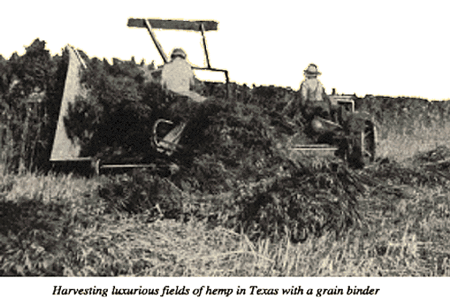
However, the connection of hemp as a crop and marijuana seems to be exaggerated. The drug is usually produced from wild hemp or locoweed, which can be found on vacant lots and along railroad tracks in every state. If federal regulations can be drawn to protect the public without preventing the legitimate culture of hemp, this new crop can add immeasurably to American agriculture and industry.
Popular Mechanics Magazine can furnish the name and address of the maker of, or dealer in, any article described in its pages. If you wish this information, write to the Bureau of Information, enclosing a stamped, self-addressed envelope.
This Year’s Farm Bill Could Deliver A New-Yet-Old Crop To American Agriculture: Hemp
There’s a long-forbidden crop on the verge of legalization, one that’s versatile and could open up new markets for farmers: hemp.
“I believe, honestly, that [hemp] is the only thing that’s really gonna bring agriculture out of the rut that it’s been in for the last 30 years,” hemp farmer Ryan Loflin said.
He lives in Colorado, one of at least 35 states that can grow hemp mainly through research pilot programs. That was a provision championed by U.S. Senate Majority Leader Mitch McConnell in the 2014 farm bill.
This year, the Kentucky Republican is calling for complete federal legalization of hemp in the Senate’s version of the farm bill, which funds safety net programs for farmers and major food assistance programs. Doing so would remove the crop from the list of controlled substances, where currently it’s lumped in alongside drugs like heroin. Unlike its close cousin, marijuana, hemp contains very little THC — and it has lots of industrial applications, from textiles to construction materials and livestock feed.
McConnell has said hemp has the attention of younger farmers in his state, once a leader in hemp production before the plant was made illegal in 1941. Some of that might be because of drought and plunging commodity prices for corn and soybeans, which are in the crosshairs of an impending trade war.
Either way, the enthusiasm isn’t just in Kentucky, though some industry leaders warn farmers to be cautious.
What farmers are waiting for?
Loflin drives his white pickup to a field near Colorado Springs, where he first planted hemp in 2015 — a year before hemp cultivation was legalized in the state. The land is dry and blanketed in blond prairie grass. Earlier this summer, this region was declared a natural disaster zone by the U.S. Department of Agriculture due to “exceptional” drought.
Loflin says his hemp grows just fine, and uses half as much water as his other crops. It isn’t clear whether that’s the case for all hemp growers.
Hemp brought Loflin, a fourth-generation farmer, back to the industry at the age of 40. He felt he couldn’t make a living growing traditional commodity crops, like wheat and corn, so he began a career in construction.
“The profitability is tough for a small-time farmer. Really, if you’re not farming multiple thousands of acres, it’s hard,” he said.
When Colorado voters passed Amendment 64 that legalized marijuana and hemp on state level, Loflin saw opportunity. And it’s been an increasingly lucrative one.
The plant itself is worth very little, but Loflin said hemp flowers can sell far as much as $100 a pound. No other crop is fetching such a price, he said, joking, except “opium maybe.”
This season, Loflin will grow 280 acres of hemp. The flowers will be harvested to make CBD oil, or cannabidiol: a tincture that’s become increasingly popular for its medical properties, though the efficacy has been debated.
Hemp Farming is Growing Among North Dakota Farmers
North Dakota has had a law on the books to support producing industrial hemp since 1997, but it wasn’t until the 2014 Farm Bill, that states were allowed to begin growing.
Renée Cooper spoke with one of the first four growers in our state.
Clarence Laub added growing hemp to his farming resume in Elgin as early as 2016.
The Farmer/Rancher explains, “It is a pilot program, so we are doing research with it. We are also marketing it and stuff like that, making money off of it. But the main purpose of the program is research, so we’re looking at adapting it into our farm and our farming practices.”
Laub says hemp is a very versatile crop.
He adds, “The seeds are very healthy for you: they can crush them for the oil, and also for the protein powders and stuff like that. And then the entire plant is useful too, the fiber and different things you can get from the plant, you can use hand-in-hand for paper products. So anything that’s made out of paper, you can make out of hemp.”
But because it looks very similar to it’s cousin, marijuana, hemp is highly regulated.
The Federal Controlled Substances Act prohibits the cultivation, processing, distribution and even the possession of industrial hemp, except when used for research purposes.
And the Agriculture Commissioner must oversee the process.
As the law stands, before hemp can be sold, the seed has to be devitalized and the plant tested for THC content.
Kentucky growers cashing in on hemp byproduct as crop makes huge comeback in state
LEXINGTON, Ky. (WKYT) –Hemp is making a huge comeback in Kentucky.
Federal and state legislation passed in 2014 says hemp can be grown and marketed in states with pilot programs. Four years later growers in the state are seeing big profits from extracting something found in the plant and turning it into a highly sought offer oil that some claim holds real health value. The sale of what is known as CBD oil is estimated to explode by 2020.
Inside one Lexington business is something many are learning is the key to their health and feeling better.
“People come in here for a variety of reasons,” said Adriane Polyniak, owner of Bluegrass Hemp Oil.
Business is booming at Bluegrass Hemp Oil, a company born out of necessity for owner Adriane Polyniak after her son was diagnosed with epilepsy and debilitating seizures in 2009.
“We went through this pharmaceutical roulette where we tried to get him regulated on those different pharmaceuticals and had him dealing with a wide array of side effects,” said Polyniak.
She found relief for her son in a product derived from hemp, CBD oil. People have found relief from a number of ailments by using it.
Polyniak believed in it so strongly that she and her husband quit their jobs and in 2014 invested in growing hemp and now processing the oil.
The Polyniaks own and operate Bluegrass Hemp Oil in Lexington.
Polyniak took advantage of the state legislation that set up a pilot program for hemp crops in the state, and then in 2014 the federal Farm Bill opened the door for the legalized cultivation of hemp in states with those pilot programs.
Her customers are now proof that CBD is changing lives.
“I think the most we’ve seen of daily pharmaceuticals that they have been able to reduce was ten, so it is definitely making a difference in people’s lives,” said Polyniak.
There is still a misconception between hemp and marijuana. Hemp grown in Kentucky is under strict guidelines that the THC level (what can make you high) must be under .3%, and if not, it is destroyed. Marijuana carries a 20-30% THC level.
CBD oil is made from extracting one of several cannabinoids from the plant.
In Harrison County if you take a walk in one of Brian Furnish’s fields you will find a crop of hemp recently planted that will be harvested in September for the use high end clothing.
Willie Nelson to launch new line of cannabis products, starting with coffee
Country music legend Willie Nelson got into the cannabis business in 2015 with a proprietary strain of marijuana. Now, Texas’ favorite stoner is expanding his brand to include several CBD products.
Monday, Nelson announced Willie’s Remedy, a line that includes several items rich in cannabidiol (CBD). CBD is a derivative of hemp, and unlike the tetrahydrocannabinol compound found in marijuana, it won’t get it you high. CBD has, however, been lauded for its health benefits.
Willie’s Remedy will debut with a CBD-infused coffee, which is expected to be available in Colorado in September. According to a statement, the whole beans include CBD sourced from organically grown, American hemp. Drinkers get 5 milligrams of CBD in each 8-ounce cup of coffee.
Willie’s Remedy is a counterpart to Willie’s Reserve, a strain of marijuana the singer launched in 2015. Both are owned by GCH, Inc., a Nelson-founded company that also recently partnered with New Belgium Brewing Co. to promote a beer called The Hemporer, which is made with hemp hearts. (P.S. It smells just like weed.) $1 from every beer sold supports the Hemp 4 Victory campaign, which aims to reform regulation to include industrial hemp as a leading agricultural crop and dismantle the taboo surrounding it.
‘It’s not the boogeyman’: Advocates push to legalize hemp farming in Texas
Texas hemp advocates want to see fields of green on farms across the state — and they’re rallying lawmakers to make it happen.
A group of hemp advocates testified Tuesday before the Texas House Agriculture and Livestock Committee about the jobs and economic opportunities that are possible if the state allows Texas farmers to grow the crop. Hemp is a variety of the cannabis plant but has low or untraceable amounts of tetrahydrocannabinol or THC, the psychoactive compound that gives marijuana users a high.
Hemp products have become a staple at smoothie shops, wellness stores and many nationwide grocery chains. Austin-based Whole Foods carries hemp protein powders and body care items, such as lotions. The lightweight and fibrous crop has been used by home builders, clothing companies and automakers, including BMW. And hemp seeds have even been used as a garnish on cocktails and entrees.
But federal law tossed hemp into the same category as its famous cousin, marijuana, and its connection with the controlled substance spooked some lawmakers.
“Everybody is starting to figure out this is actually a good thing, and it’s not the boogeyman,” said Jim Reaves, the state legislative director of the Texas Farm Bureau.
In his testimony, he said the crop would give farmers another option, especially during tough years for corn, cotton or other Texas crops. The net income that Texas farmers and ranchers receive from commodities has dropped more than 50 percent in the last four years, he said.
The debate over hemp is another example of how lawmakers and industry leaders are trying to reconcile harsh federal drug laws with a growing demand for cannabis-related products — including the ones that don’t give consumers a high. Texas has held the line, even as other states have approved pilot programs to farm industrial hemp. Some states, like Colorado and Maine, have gone further by legalizing recreational use of marijuana.
Minnesota farmers hope for hemp in 2018 Farm Bill
(KMSP) – As the 2018 Farm Bill makes its way through Congress, some Minnesota farmers are eyeing a measure that would legalize industrial hemp.
Often called “marijuana’s kissing cousin,” the plant won’t get you high. Right now, however, it is still a controlled substance, only grown legally in the US through experimental research.
At a hemp field off the interstate in Woodbury, the ancient plant is in bloom once again.
“This is our third growing year. We were the first growers in the state of Minnesota,” said John Strohfus, Founder and CEO of Minnesota Hemp Farms.
Growing hemp without a special permit is illegal. So, Strohfus and other farmers plant and harvest it through a pilot program with the Minnesota Department of Agriculture.
“There is really no difference genetically between hemp and marijuana except for the varieties, which have low THC,” Strohfus said. “Literally, you could smoke a field of this and you’ll just get a headache.”
An entrepreneur at heart, Strohfus saw the crop as a business opportunity. After harvest, the hemp is processed and used in products like clothing, rope, oils and food.
“Hemp is not a new crop, but there’s a renaissance in growing hemp in the United States, and I knew that with that would come a lot of opportunity to be one of the early adopters,” Strohfus said.
Now Strohfus and other Minnesota hemp farmers are looking to congress to pass the recent Farm Bill. Both the House and Senate have passed their own versions, and the Senate’s bill includes full legalization of industrial hemp. If passed, it would remove hemp from the federal list of controlled substances, allowing farmers to apply for crop insurance and federally funded programs.
“The United States is the number one importer of hemp in the world. And so for us not to be able to grow it is quite silly,” Strohfus said.
“It grows very well here. We also got in pretty early on the ground floor,” said Andrea Vaubel, Assistant Commissioner at the Minnesota Department of Agriculture. “There are now 39 states that have these pilot programs, but we are certainly one of the leaders amongst others like Colorado and Kentucky. So we’re really proud of that and we feel like we can continue to be a leader, particularly if this becomes law.”
“I think it would be a relief that we don’t have to constantly address the issue of is it legal or not,” Strohfus said.
Because the plants look so similar there have been concerns from law enforcement on how they would be able to tell a legal hemp field from a field of marijuana.
At the University of Minnesota’s St. Paul campus, scientists are working to resolve that very problem.
“We’ve been working on cannabis genetics in my laboratory for the last 15 years, including both hemp and marijuana. Our work started with an effort to understand how hemp and marijuana are different. We know that now,” said Dr. George Weiblen, University of Minnesota Professor in the Department of Plant and Microbial Biology.
In the lab, Weiblen and his team dissect hemp seeds down to their DNA.
CA Dept. of Public Health issues misguided statement on “hemp foods”
As you may know, California’s Department of Public Health (“CDPH”) issued a misguided FAQ stating that hemp derived CBD and extracts are prohibited food additives in the state, echoing the FDA’s position. It should be noted that CDPH’s policy in this area is in conflict with many other states that have authorized the cultivation of industrial hemp and its use as a food, food additive and food supplement. Vote Hemp believes the FAQ is fundamentally flawed and in conflict with state law.
Proposition 64 authorized the cultivation of industrial hemp, independent from cannabis, and in doing so approved the use of any part of the plant. – California Health and Safety Code § 11018.5.
CBD in and of itself is not scheduled under the federal Controlled Substances Act. Rather, it is a controlled substance when it is sourced from marijuana, but not from industrial hemp.
The arbitrary prohibition of industrial hemp derived CBD in food products will have a chilling effect on the hemp cultivation industry at the very moment the industry is beginning its launch in California.
Industrial Hemp is treated as an agricultural product in California and, as such, is regulated by the California Department of Food and Agriculture.
Vote Hemp and other stakeholders sent a coalition letter to CDPH in strong opposition to the FAQ.
For over a decade, Vote Hemp has worked in California to pass hemp legislation. These efforts continue this year through Vote Hemp’s sponsorship of SB 1409 that will improve the existing state hemp statute. SB 1409 accomplishes several objectives, including:
- authorizing the California Department of Food and Agriculture to run a pilot program under Sec. 7606 of the Farm Bill to ensure the registration program is compliant with federal law;
- removing a number unnecessary law enforcement-minded provisions to help streamline production
- other technical amendments needed to align existing state law with language that was passed by voters in Proposition 64
SB 1409 passed out of the Senate and Assembly and is now sitting on the Governor’s desk.
Vote Hemp continues to look for opportunities to further advance the industry and legislation in the area of hemp processing and registration will most likely be brought forward in a subsequent session.